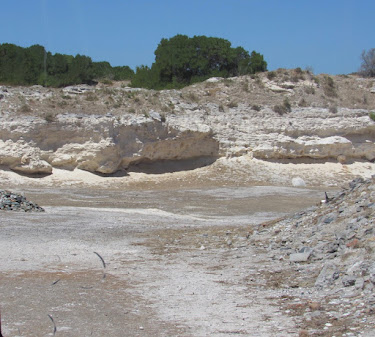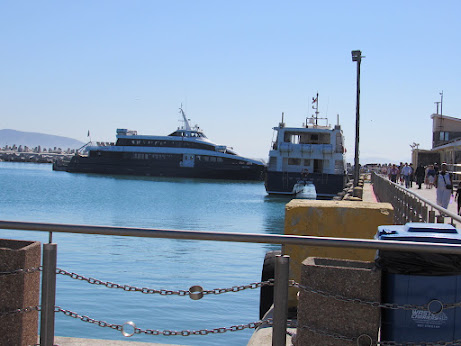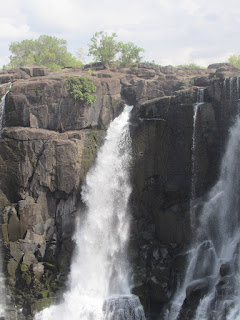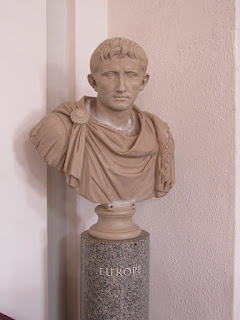One of the major reasons I have long wanted to go to South Africa was to see Robben Island where Nelson Mandela served 18 of 27 years of imprisonment for his struggle against Apartheid. The safari offered a five-day post-trip extension that allowed me to go there, and I'm so glad I did!
Robben Island helped to shape Mandela, the first Black South African president (1994-99) and recipient of the Nobel Peace Prize. It had helped teach a man to hold hands with his jailer when he was inaugurated president--and then to lead his wounded nation that had been full of hate, fear, and racial discrimination for centuries to a full, multi-racial democracy. This same man was then able to inspire common South Africans to participate in the Truth and Reconciliation Commission where victims forgave their persecutors who in turn admitted their crimes publicly and in community with the hope of resolving conflicts left over from the past. South Africa then inspired 52 other countries to follow this same path to resolving their internal conflicts. Robben Island is a testament to the strength of the human spirit in the face of utter injustice and holding on to hope and a total conviction for the cause of freedom.
The 1.9 square mile island, 4.5 miles off the coast of Cape Town had originally been a haven for seals, birds, and penguins. Later, in 1652, it was used to protect the early Dutch settlers' sheep from the wild animals of the mainland. Since the late-seventeenth century the island held prisoners. From 1962-1991, Black, Indian, and mixed-race inmates called Coloreds were
held in what became a maximum security prison. It remained a medium security prison for criminal prisoners until 1996 when it was closed. Robben Island is now a national museum and a World Heritage Site.
Welcome
 We were welcomed to the island by our guide, a former prisoner. He treated us a bit like prisoners so that we could get a sense of what life was like in an Apartheid maximum security prison. Rules were strict and his speech was brusque. For example, if you got lost from your group, you may not be able to board the ferry boat back to the mainland. Take photos of the various rooms of the prison and don't linger because we had to make room for the next group.
We were welcomed to the island by our guide, a former prisoner. He treated us a bit like prisoners so that we could get a sense of what life was like in an Apartheid maximum security prison. Rules were strict and his speech was brusque. For example, if you got lost from your group, you may not be able to board the ferry boat back to the mainland. Take photos of the various rooms of the prison and don't linger because we had to make room for the next group.
Our guide described prison life. If you were told to take dirt from bucket A and then put it in buck B, you had to do it exactly right or you could lose privileges or incur punishment. It didn't matter why you had to do it. The system was designed to dehumanize and humiliate prisoners who were deemed dangerous to the ruling White government.

The prison yard was fenced off with barbed wire so that there was little opportunity for escape.
This room was used to process prisoners. Handcuffs and leg irons were removed. Prisoners were stripped and their personal information was recorded. They were given a prison card with a prison number and were ranked from D to A. The lowest rank was D and A was the highest rank with more privileges. You could move up or down the ranks for the smallest of infractions.
The room was also used as a
courtroom. Prisoners from the 1960's testified to prisoners being
beaten here.
This sign designates the hallways for grades A and C.
Prisoners were issued prison clothes. In the 1960s, Africans were given short pants, shirts, moleskin jackets and sandals, and no underpants. Colored and Indian prisoners were given long pants, shirts, jackets, underpants, socks, and shoes. Africans received long pants beginning in 1971.
Nelson Mandela's prison cell

The stark emptiness of the cell contrasts Mandela's life after prison where he inspired a world to forgive those who were persecuted by others. However, he says that it was the solitude and emptiness of his prison cell that allowed him to be inspired.



Mandela reflects on his prison cell and its influence on his life.
Outside Mandela's cell block was this open area below. The photo on the right shows the prisoners partaking in some sort of exercise. The photo on the left is our group visiting the area several decades later. Mandela secretly wrote his book, Long Walk to Freedom while in prison on Robben Island.

Prisoners' letters often had parts of them censored.
"In '64 we were not allowed anything. Nothing; only your face-cloth, your toothbrush, your spoon and your clothes, of course. And soap. We drew the board on the floor of the cell with a little bit of soap. We drew the different chess pieces on cement bag paper and played chess with those flat pieces of paper."
Testimonials by former prisoners describe their lives.


For more prisoner stories, see the Robben Island website.
Breaking the Silence of the 1960s
The South African Student Organisation (SASO) was formed in 1969. This was the birth of the Black Consciousness Movement under the leadership of Steve Bantu Biko. SASO organized in universities and conscientized the high school students who led the 1976 student revolt against being forced to learn in Afrikaans language. "Black Power!" was the slogan of a new generation challenging Apartheid.
The
SASO 9 were sentenced to 5 years in jail for organizing the Viva
Frelimo rallies after the fall of the Portuguese government in
Mozambique in 1974. The SASO 9 leaders were sentenced in
December 1975 and brought to Robben Island.
"We were young intellectuals. We were all in our twenties. When walked in the prison corridors, we would raise our fist and shout: Black Power."
The limestone mines occupied the work life of the prisoners. They spent most of their day there digging the soft white rock without eye protection as the sun beat down on them in a blinding light. This intense light damaged their eyes. After Mandela became president, the press were not allowed to use flashes or shine bright lights on him because of the damage done to his eyes working in these mines.
The mines also served as covert classrooms where the prisoners secretly offered classes to one another so they would be ready to participate in the eventual post-Apartheid period. Inmates used to say that they graduated from the University of Robben Island with professional degrees in law, accounting, medicine, etc.
After many years of struggle, prisoners were given the right to study. They registered with institutions like the University of South Africa (UNISA), Damelin, Rapid Results College, and the University of London. Prisoners were supported by their families and organizations like the Red Cross (ICRC), International Defense Aid Fund, and Amnesty International.
Other open spaces at the prison.

During the 19th century Robben Island was used for people suffering from leprosy and mental illness to keep them away from the mainland. The leper colony was maintained until 1931. Here is the cemetery where these people were buried.
V&A
Waterfront was named after Queen Victoria and her son, Alfred, was
built in the 19th century as a stopover for European ships. Today it has
a variety of shops, restaurants, the Two Oceans Aquarium, and the ticket office for ferry rides to Robben Island.
Robben Island is accessible for tours by ferry boat. Tickets and visiting times are limited presumably as a means of crowd control over the number of people allowed in the former prison. We were lucky that Stanton, our local guide, had connections to get three of us on the ferry boat when the tickets had sold out.
These
buses took us on a tour of various other places on the island: the
quarry, the Christian Reformed Church, the superintendent's home, the
leper cemetery, and the souvenir shop and refreshment stand.
The Robben Island shoreline is beautiful and serene after four centuries of turbulent history.
Resources
https://www.nationalgeographic.com/travel/world-heritage/article/robben-island
https://www.robben-island.org.za/
https://en.wikipedia.org/wiki/Robben_Island



































































































